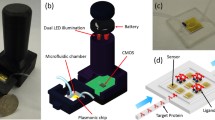Abstract
A novel fluorescence-based optical platform for the interrogation of an optical biochip was designed and developed. The optical biochip was made of poly(methyl methacrylate) (PMMA) formed by two pieces of PMMA appropriately shaped in order to obtain four microchannels that are 500-μm wide and 400-μm high. The lower part includes the microchannels and the inlet and outlet for the fluidics, while the sensing biolayer was immobilized on the upper part. The optical signal comprised the fluorescence emitted by the biolayer, which was anisotropically coupled to the PMMA cover and suitably guided by the PMMA chip. The potentiality of the optical chip as a biosensor was investigated by means of a direct IgG/anti-IgG interaction carried out inside the flow channels. The mouse-IgG was covalently immobilized on the internal wall of the PMMA cover, and the Cy5-labelled anti-mouse IgG was used for the specific interaction. Several chemical treatments of the PMMA surface were investigated, poly(L-lactic acid), Eudragit L100 and NaOH, in order to obtain the most effective distribution of carboxylic groups useful for the covalent immobilisation of the mouse-IgG. The treatment with Eudragit L100 was found to be the most successful. Limits of detection and quantification of 0.05 μg mL−1 and 0.2 μg mL−1, respectively, were obtained with the configuration described.











Similar content being viewed by others
References
Vo-Dinh T (2003) Biochips and microarrays: tools for the new medicine. In: Vo-Dinh T (ed) Biomedical photonics handbook. CRC, Boca Raton
Vo-Dinh T, Cullum B (2000) Fresenius J Anal Chem 366:540–551
Ligler FS, Taitt CAR (eds) (2002) Optical biosensors: present & future. Elsevier, Amsterdam
Homola J, Lu HB, Nenninger GG, Dostàlek J, Yee SS (2001) Sens Actuat B 76:403–410
Gauglitz G, Brecht A, Kraus G, Nahm W (1993) Sens Actuat B 11:21–27
Dieterle F, Belge G, Betsch C, Gauglitz G (2002) Anal Bioanal Chem 374:858–867
Ligler FS, Rowe-Taitt CA, Shriver-Lake LC, Sapsford KE, Shubin Y, Golden JP (2003) Anal Bioanal Chem 377:469–477
Barzen C, Brecht A, Gauglitz G (2002) Biosens Bioelectron 17:289–295
Epstein JR, Biran I, Walt DR (2002) Anal Chim Acta 469:3–36
Proll G, Tschmelak J, Gauglitz G (2005) Anal Bioanal Chem 381:61–63
Blum LJ, Marquette CA (2006) Chemiluminescence-based sensors. In: Baldini F, Homola J, Martellucci S, Chester A (eds) Optical chemical sensors. NATO Science Series, Springer, The Netherlands
Proll G, Steinle L, Proll F, Kumpf M, Moehrle B, Mehlmann M, Gauglitz G (2007) J Chromatogr A 1161:2–8
Moreno-Bondi MC, Taitt CR, Shriver-Lake LC, Ligler FS (2006) Biosens Bioelectron 21:1880–1886
Preininger C (2006) DNA and protein arrays. In: Baldini F, Homola J, Martellucci S, Chester A (eds) Optical chemical sensors. NATO Science Series, Springer, The Netherlands
Stuart H, Hall D (1998) Phys Rev Lett 80:5663–5666
Polerecky L, Hamrle J, MacCraith BD (2000) Appl Opt 39:3968–3977
Baldini F, Carloni A, Falciai R, Giannetti A, Mencaglia A, Porro G, Trono C (2007) Optical PMMA chip for multianalyte detection. In: Cutolo A, Culshaw B, Lòpez-Higuera JM (eds) Third European Workshop on Optical Fibre Sensors. Proceedings of SPIE 6619:661923-1-661923-4
Piruska A, Nikcevic I, Lee SH, Ahn C, Heineman WR, Limbacha PA, Seliskar CJ (2005) Lab on Chip 5:1348–1354
Acknowledgments
This research study was supported by the European Community within the framework of the five-year EU funded project under IST priority, CAREMAN (HealthCARE by Biosensor Measurements and Networking). The authors wish to thank Lorena Tedeschi of the Institute of Clinical Physiology of Pisa for her positive collaboration and fruitful suggestions.
Author information
Authors and Affiliations
Corresponding author
Rights and permissions
About this article
Cite this article
Baldini, F., Carloni, A., Giannetti, A. et al. A new optical platform for biosensing based on fluorescence anisotropy. Anal Bioanal Chem 391, 1837–1844 (2008). https://doi.org/10.1007/s00216-008-1904-4
Received:
Revised:
Accepted:
Published:
Issue Date:
DOI: https://doi.org/10.1007/s00216-008-1904-4




